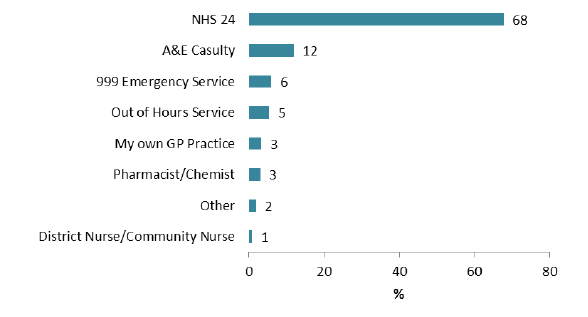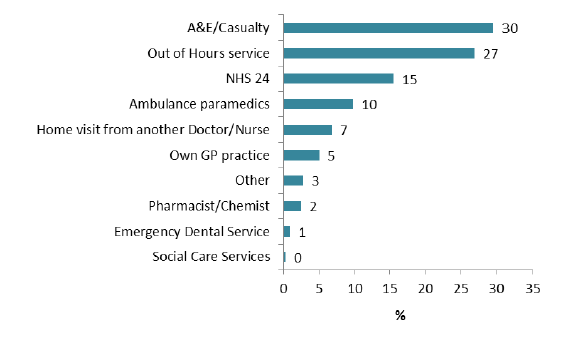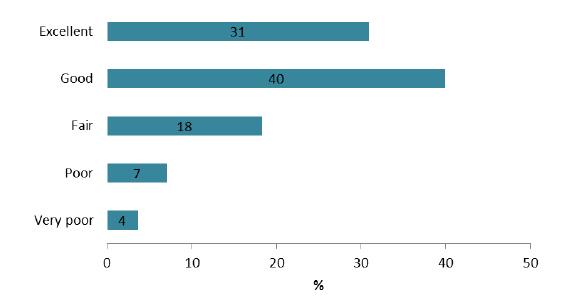Health and Care Experience Survey 2013/14 Volume 1: National Results
Results from the 2013/14 Health and Care Experience Survey.
This document is part of a collection
10 Out of Hours Healthcare
Summary
10.1 Similar to other areas of the survey, results for out of hours questions are slightly less positive than in the previous survey. The overall rating of out of hours care has fallen slightly from 72% positive in 2011/12 to 71% in this survey.
10.2 By far the most common first port of call for out of hours care was NHS 24 (68% of patients contacted NHS 24 first). The out of hours services that most patients were ultimately treated by were A&E/Emergency department (30%) and Out of Hours Service (27%).
10.3 The most positively rated out of hours service were Ambulance/Paramedics, who received the highest positive results for each of the questions relating to out of hours care.
Introduction
10.4 From 1 April 2004, the Primary Medical Services (Scotland) Act 2004 placed a duty on NHS boards to provide 'primary medical services' for everyone living in the NHS board area. These are the services provided by GP practices to patients registered with them. NHS boards have a legal responsibility to ensure these services are provided at all times, including out-of-hours.
10.5 The out-of-hours period is: the period beginning at 6.30pm from Monday to Thursday and ending at 8.00am the following day; the period between 6.30pm on Friday and 8.00am the following Monday; and Christmas Day, New Year's Day and other public or local holidays.
10.6 Since 2004, GPs have had the option of continuing to provide a service during the out-of-hours period or to opt out of providing this service on condition that there is an acceptable alternative. Over recent years alternative arrangements for providing out-of-hours care have been established. In many cases this involves a number of agencies and healthcare professionals working together to provide an integrated service for patients.
10.7 Many patients contact the NHS in a way that is unplanned, for example if they become ill during the day or night, or at the weekend. It is crucial that the NHS responds in a way that meets the needs of the patient in a timely, person centred, safe and clinically appropriate way. Often the journey of care will involve more than one part of the healthcare system so it is important for systems and process to be joined up, and for patient information to be shared by the healthcare professionals involved in supporting patients.
Use of out-of-hours NHS services
10.8 Of patients surveyed, 25 per cent had tried to get medical help, treatment or advice, for themselves or someone they were looking after, when their GP surgery was closed.
10.9 Of these patients, by far the most common first port of call was NHS 24, which was contacted first by 68% patients. The next most common was A&E/casualty services which 12% of patients approached first. (Figure 15)
Figure 15: Service patients spoke or went to first when they tried to get help out of hours

10.10 Over half of patients who contacted a service outside their GP surgery opening hours ended up being treated by either A&E/Casualty services or an out of hours service (30 per cent and 27 per cent respectively). Another 15 per cent of patients received phone advice only. (Figure 16)
Figure 16: Service patients ended up being treated by when they used out-of-hours services

10.11 The most common journeys through out-of-hours services, accounting for over 60% of instances were:
- Patients contacted NHS 24 first and were then seen by an out-of-hours service (21%);
- Patients contacted NHS 24 first and were then treated in A&E/ Casualty (14%);
- Patients contacted NHS 24 and received phone advice only (14%);
- Patients visited A&E / casualty first and were treated there (12%) (Table 9)
10.12 The last bullet point partially reflects the fact that 93% of patients who visited A&E as their first port of call were ultimately treated there. This is by far the highest percentage of patients being treated at their first port of call of any service (Table 10). This could suggest that patients are generally able to judge when a trip to A&E is appropriate, or alternatively could reflect a reluctance to redirect patients who present at A&E to alternative out of hours services.
Table 9: percentage of patients being treated by each service, by the service they spoke to first.
| Service patient ended up being treated by |
||||||||||
|---|---|---|---|---|---|---|---|---|---|---|
| Service patient spoke to first |
NHS 24 |
Pharmacist/ Chemist |
Out of Hours Service |
Own GP practice |
Home visit from another doctor/nurse |
Emergency Dental Service |
Ambulance Paramedics |
A&E/Casualty |
Social Care services |
Other |
| NHS 24 |
14 |
* |
21 |
2 |
6 |
1 |
6 |
14 |
* |
1 |
| Pharmacist/Chemist |
* |
2 |
* |
* |
* |
* |
* |
* |
* |
* |
| Out of Hours service |
* |
* |
4 |
* |
* |
* |
* |
1 |
* |
* |
| Own GP practice |
* |
* |
* |
3 |
* |
* |
* |
* |
* |
* |
| District nurse/ community nurse |
* |
* |
* |
* |
* |
* |
* |
* |
* |
* |
| 999 Emergency service |
* |
* |
* |
* |
* |
* |
3 |
2 |
* |
* |
| A&E/Casualty |
* |
* |
* |
* |
* |
* |
* |
12 |
* |
* |
| Other |
* |
* |
* |
* |
* |
* |
* |
* |
* |
1 |
Note: * denotes less than 1%
Table 10: Percentage of patients who approach each service that are ultimately treated by that service
| Service |
% |
|---|---|
| NHS 24 |
22 |
| Pharmacist/Chemist |
61 |
| Out of Hours service |
62 |
| Own GP practice |
66 |
| District nurse/community nurse |
43 |
| 999 Emergency service (treated by ambulance/paramedics) |
58 |
| A&E/Casualty |
93 |
| Other |
60 |
Experience of out-of-hours healthcare
10.13 Patients were asked to rate their overall experience of the care provided by out-of-hours services.
10.14 In total 71 per cent of patients rated the overall care they received out of hours as excellent or good (a modest drop from 72% last year) (Figure 17). As in the previous survey fewer patients rated out-of-hours care positively than the overall care provided by their GP practice, where 87 per cent rated their care as good or excellent.
Figure 17: Overall rating of out-of-hours care

10.15 The survey also asked patients who had tried to get help out of hours how much they agreed or disagreed with six statements:
- The time I waited was reasonable
- I felt that the person had all the information needed to treat me
- I felt I was listened to
- Things were explained to me in a way I could understand
- I felt that I got the right treatment or advice
- I felt that people took account of the things that matter to me
10.16 The most positively rated statement were that things were explained to patients in a way they could understand (85%) and that they felt listened to (84%).
10.17 In line with results for GPs and nurses, the statement that the fewest patients agreed with was that people took account of the things that matter to them (74 per cent).
10.18 Consistent with most other aspects of the survey, responses for out of hours care are slightly less positive than the previous survey. Of the 5 statements comparable with the previous survey, 2 have worsened to a statistically significant degree and none have improved (Table 11).
Table 11: Summary results of out-of-hours services
| Statement |
Strongly agree/ agree (%) |
Neither agree nor disagree (%) |
Disagree/ strongly disagree (%) |
Change since 2011/12 |
|---|---|---|---|---|
| The time I waited was reasonable |
75 |
9 |
16 |
-1 |
| I felt that the person had all the information needed to treat me |
76 |
12 |
12 |
-1 |
| I felt I was listened to |
84 |
9 |
8 |
0 |
| Things were explained to me in a way I could understand |
85 |
10 |
6 |
-1 |
| I felt that I got the right treatment or advice |
79 |
11 |
10 |
-1 |
| I felt that people took account of the things that matter to me |
74 |
16 |
10 |
N/A |
Note: Only changes in bold are significant
Differences between services
10.19 Responses varied depending on the out of hours service that patients were treated by. Ambulance/Paramedics received the most positive ratings for each of the specific statements. Those who were ultimately treated by Ambulance/paramedics also provided the most positive rating for overall out of hours care.
10.20 Those that ultimately received out of hours treatment from their own GP practice gave the lowest overall rating for out of hours care (61% positive). This is an interesting result when contrasted with the higher overall rating given by those seen by an out of hours service (74% positive), as the two services receive broadly similar results for the other questions (Table 12).
10.21 The difference in overall rating may therefore represent patient dissatisfaction with the process of accessing 'out of hours' care, which ultimately ends up being provided by their local GP - even though this may be clinically appropriate.
Table 12: Percentage of patients responding positively to out-of-hours questions, by service they were ultimately treated by.
| Service treated by |
Overall rating of out-of-hours care |
Time waited was reasonable |
Person had all the information needed to treat me |
I felt listened to |
Things were explained in way I could understand |
I felt I got right treatment or advice |
People took account of the things that matter to me |
|---|---|---|---|---|---|---|---|
| Phone advice from NHS24 only |
63 |
71 |
70 |
80 |
80 |
72 |
69 |
| Pharmacist/Chemist |
71 |
88 |
80 |
90 |
89 |
83 |
77 |
| Out of Hours service |
74 |
77 |
77 |
86 |
87 |
81 |
76 |
| Own GP practice |
61 |
77 |
79 |
84 |
83 |
79 |
76 |
| Home visit from another doctor/nurse |
75 |
76 |
73 |
87 |
87 |
83 |
78 |
| Emergency Dental Service |
78 |
84 |
85 |
84 |
88 |
85 |
80 |
| Ambulance paramedics |
82 |
88 |
85 |
90 |
90 |
88 |
86 |
| A&E Casualty |
69 |
67 |
75 |
82 |
84 |
79 |
73 |
| Other |
60 |
66 |
65 |
71 |
74 |
66 |
63 |
Contact
Email: Andrew Paterson
There is a problem
Thanks for your feedback